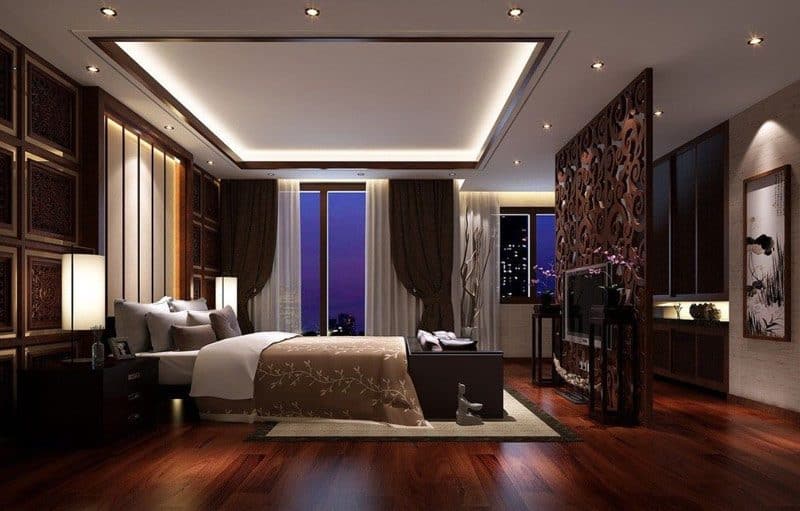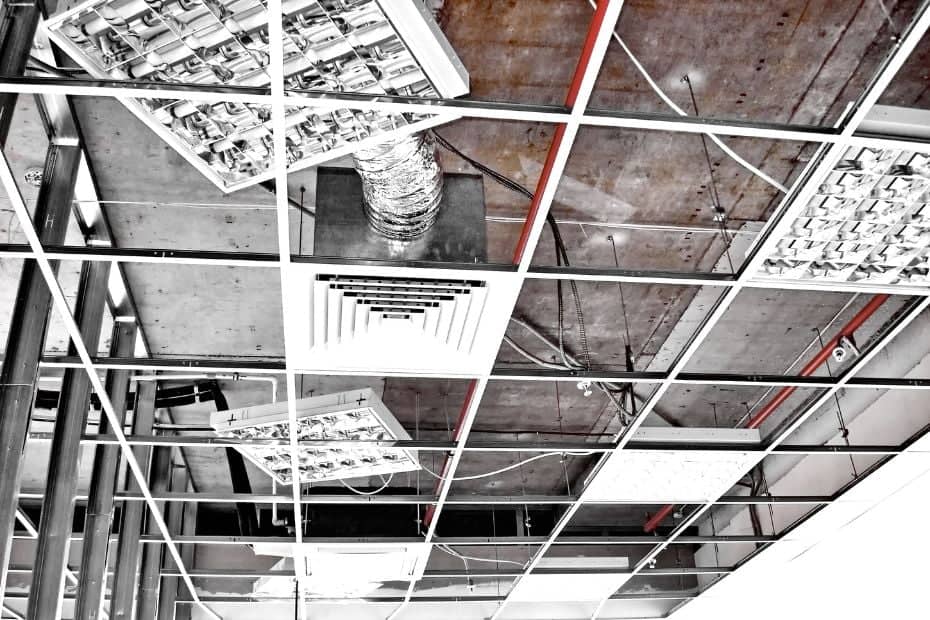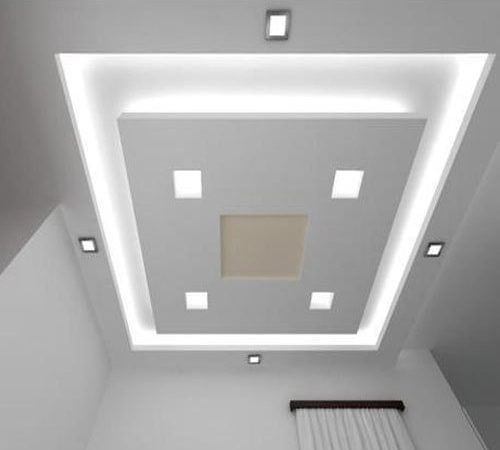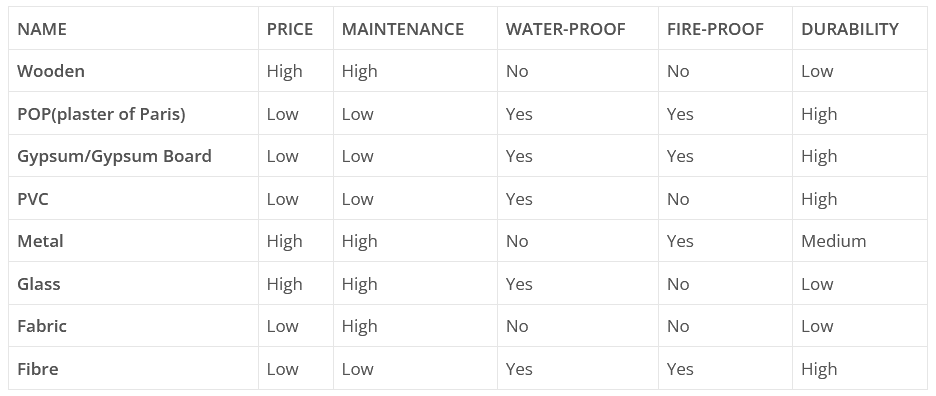False Ceiling Design
False Ceiling
A false ceiling is an extra ceiling that is hung below the main ceiling. It can be used to hide ductwork, wiring, or other unsightly things, and it can also help a place sound better. Gypsum board, plaster, metal, and wood are some of the other materials that can be used in false ceiling design. They can be decorated with paint, lights, or other things.

During the Muromachi Period (1337–1573), this style of design was popular in Japan. It has quickly become an important part of modern architecture. Included in both private and business buildings, it can be found. Additionally to making a room look better, a false ceiling may also help with soundproofing, insulation, and lighting, and it may make the ceiling look lower than it really is. A false ceiling is also known as a drop ceiling, a suspended ceiling, a grid ceiling, or a T-bar ceiling. The same words can also be used for false ceilings.
What is the purpose of the false ceiling?
A house or commercial structure that doesn’t have a proper roof is thought to be unfinished. A building’s roof is its very top part. It’s an important part because it protects the building from things like wind, extreme heat or cold, sun, snow, and rain. The underside of a roof not only protects the building, but it also lets the people who live there show off their sense of style by making false ceilings out of decorative ceiling panels that are meant to look good.




In addition to making a room look better, false ceilings can also be useful in a number of ways. False ceilings are great for acoustics because they let desired sounds get louder while reducing unwanted noises. The space they give you can be used to store things like electrical lines, pipes, and air conditioning ductwork. False ceilings can reduce the need for unnecessary artificial lighting by reflecting and diffusing light, which helps to lower energy use overall. These ceiling panels are not only safe in those two important ways, but they are also resistant to moisture.
For that reason, a well-thought-out false ceiling has features that are both useful and attractive, which could make the workplace much better.
Advantages of False ceilings
- Insulation: Putting down a layer of ceiling below the actual ceiling creates a layer of air that is trapped between the two surfaces. This helps keep the room at a steady temperature. Lowering the ceiling makes a big difference in how well the air conditioner works because there is less space.
- Acoustics: The plenum space, which is the trapped air between the surfaces, and the materials used to make the false ceiling, especially wood and fiber, help sound waves travel through the room. This is an important part of sound waves. If you put up false ceilings in your living room or game room, you might have a better time. This makes the sound better in the space.
- Illusion: Elevated ceilings can throw off the proportions of furniture to rooms. This is especially true in buildings with high ceilings. There is a common practice of building a false ceiling to fix the look. This gives the impression of a lower ceiling, which in turn makes the furniture look bigger and better suited to the room it’s in.
- Pipelines and Electrical Wiring: If there is a false ceiling, also called a faux ceiling, it hangs below the real ceiling and leaves a big empty space between them. Pipelines and electrical wiring could be put in this space, which could be very useful.
- Ease of modification: Not much work is needed to take off the panels that were used to build the ceiling, which makes getting to the plenum area easy. Maintenance tasks, installing new plumbing, and making changes to or replacing electrical wiring are not hard to do.

Disadvantages of False ceilings
- Reduced headroom: Many times, what seems like a lower ceiling ends up being a problem because it limits the number of installations that can be done in buildings with limited space or headroom. Things that are bad about the materials that are used: Each building material has its own pros and cons. Mineral fiber and other materials like it show their age very quickly because they sag, are sensitive, and stain easily and permanently. Some materials, like metal, gypsum, or POP, last a lot longer than others.
- Concerns about the ability to conceal: When a false ceiling is put up, you can’t see the real ceiling or the pipes and wiring that are above it. Not only does this change the way the space looks, but it also makes it harder to tell if there has been any damage or defaults.
False Ceiling Design
First, you have to figure out the size and shape of the space that the false ceiling will cover. This will help you figure out what size and shape false ceiling you need. Based on the room’s size and shape, the designer can start making plans for the false ceiling. This includes choosing whether the false ceiling will be flat or curved, and whether it will be for looks or for use.
False ceiling designs can take on a variety of different shapes depending on what they are going to be used for. There are several types of materials used to make these ceiling tiles, and each one gives them a unique look. It is possible to make complicated patterns with false ceiling panels, and they may also make the ceiling look better.

False ceiling Design based on Material
The main thing that separates false ceilings into different groups is the type of material that was used to make them. Both good and bad things can be said about each substance. The mix of materials might be good for both how it looks and how it works.
Some types of false ceiling panels that are commonly used are shown below:
Gypsum false ceiling design
Calcium is what gypsum comes from, and it is used to make ceilings that are very light. Usually, they are in the shape of boards that are hung from the ceiling with iron or wooden frames. A little paint is then put on them.

This material is often used to make false ceilings because it is light, well-insulating against sound and heat, and not easily caught on fire. Another thing about it is that it is soft. It is possible to make a false ceiling by hanging square gypsum boards from an iron frame. Gypsum comes in many colors when it is found in nature, such as brown, white, red, yellow, and grey.
Besides that, you can get it in a transparency or colorless form. After the gypsum boards are finished, laminates and paints can be put on their surfaces to make them look better. It is also possible to cover gypsum boards with wallpaper or give them a textured finish. Gypsum is very flexible and can be easily shaped into many different surfaces with different textures and shapes, such as flat, curved, stepped, and coffered ones.
Once the shape, size, and design of the false ceiling have been chosen, it is easy to put up. It is known for being able to soak up noise and heat, and its surface is smooth and perfect. One more benefit is that it’s very light, so it’s easy to hang from an iron board that’s already attached to the ceiling. Putting up a false gypsum ceiling in your living room would be the best idea.
Gypsum false Ceiling Price Per Square Foot: $50 to $150
POP false ceiling design
Plaster of Paris, or POP, is the main material used in most false ceiling designs. When gypsum is heated, it melts, releases water, and changes into POP! When water is added to POP, it instantly becomes stiffer. Putting it on a fiberboard or wood base and then hanging it from the ceiling makes the false ceiling look like a real ceiling. These POP false ceilings not only last a long time, but they also look good. They are pretty good at keeping heat from moving through them.

After gypsum (POP), plaster of Paris is the next most popular choice for a false ceiling material. The main thing that goes into making this powder is gypsum, and it is sold in powdered form. After being heated to high temperatures, gypsum turns into POP, which is then mixed with water to make a paste. With a POP false ceiling, you can shape it into any shape you want, but not with a gypsum false ceiling. Because of this, POP false ceiling designs can be put together in a huge number of different ways. The price is much lower than that of gypsum, which is important to remember.
For whatever reason, the process of building a POP false ceiling is hard. This process can take weeks because the pattern has to be carved into a chicken mesh after the paste is made.
By installing this type of drop ceiling, you can hide unsightly parts of the building’s structure, like ventilation pipes and conduits, and make the ceiling smoother at the same time.
POP doesn’t need any upkeep and lasts a very long time. There are many patterns that can be used for POP false ceilings, and they can be finished in many ways, such as with a smooth, even finish. The designs can also be very flexible. Furthermore, it is an excellent substance for enhancing the lighting that is already there. One of the main problems with POP is that it tends to break over time.
Plaster of Paris cost Per Sq. Ft. ₹50–₹150
Wood false ceiling design
When you want to combine modern and classic styles, wood is the best material to use. It is possible to make any room look better by adding a false ceiling made of wood. This is because wood can be decorated in many different ways. Apart from that, it is also in charge of acoustics. By buying some beautiful pendant lights and hanging them from the ceiling, you can turn your home into a scene from a movie. Gypsum or POP false ceilings are more durable and don’t cost as much as false wood ceilings.

There are some people who like the peace and beauty of nature or a rural setting in their own homes. Installing wood panels on the ceiling is the best way to give a room a rustic look like this one. There are different ways to arrange these wooden panels, and each one makes the ceiling look more modern and nice. Wooden false ceilings are another great way to make the focal point of a room.
These days, homeowners are more likely to choose false ceilings made of wood because of the natural looks and textures of the material. There are also different treatments on these ceilings that make them look better of course.
You can make a false ceiling out of wood in a number of ways, such as with hollow wooden blocks, wooden panels, wooden boards, or plywood. Putting the wooden blocks together is easy when you use nails and screws. They are often used in places where it gets cold.
There are lovely natural patterns and textures on false ceilings made of wood that look good to the eye. Wood is fun to work with because it has a nice texture. Wood can be used to make paneling in the form of hollow blocks, boards, or even panels. Most of the time, just a few screws and nails are enough to complete the job. They can stand up to normal wear and tear, but termites can get into them and cause them to warp. They can be finished in a number of ways, such as by painting them in the right colors and shades.
Panels made of wood are one of the most expensive options because the material is expensive to buy and costs more to maintain over time. If you don’t mind spending a lot of money, on the other hand, wood ceiling panels may look great and give the ceiling a luxurious and classy look.
Wooden False Ceiling Cost Per Sq. Ft.: ₹80–₹650
Fibre false ceiling design
Fiberglass false ceilings often look like tiles. These structures are made of both natural and man-made materials, such as wood, stone, tar, and many others. Not only are these false ceilings strong and long-lasting, they are also cheap and don’t let noise or heat through.

Because they are cheap and good at blocking out noise and heat, false fiber ceilings are often used in commercial buildings and areas. These ceilings, on the other hand, are often plain and boring. Another option is to put up a false fiber ceiling in either a basement or a storage room.
Ceiling tiles made of mineral fiber are made with minerals, which can be natural or man-made. Mineral tiles made of ceramics are used to make this type of drop ceiling. They are strengthened with natural stone, wood, vegetable fiber, bitumen, and tars. The overall improvement in the product’s insulating power is due to these parts. Because of this, they are perfect for places that need to keep out noise and heat. A lot of different sizes, shapes, and patterns are available for the mineral fiber ceiling tiles. These are not only cheap, but also simple to put in! Fiber ceiling tiles can also be used to block out noise, which makes them perfect for business settings.
Fiber false ceilings are quickly becoming more popular in business settings because they are easy to find, don’t cost much, and have many useful benefits. Due to their less appealing appearance, fiber ceiling panels are not a good choice for use in homes.
Metal false ceiling design
Also, false ceilings made of metal are quite common in domestic construction. Because of how they are made, aluminum and galvanized iron were chosen because they last a long time, are very strong, and are great at reducing noise. There are many patterns and shapes of metal false ceilings to choose from, and they are also easy to clean. Besides that, it has an old-fashioned charm. Anyone can choose any color they want to paint the ceiling. Metal false ceilings, on the other hand, tend to be more expensive than gypsum or POP false ceilings.

Metal is a durable building material that can be used to make homes. Through its sheen, the material gives the rooms an air of class and elegance. A metal false ceiling can be made in three main styles: ceiling tiles, ceiling planks, and ceiling panels. The two metals most often used for drop ceilings are aluminum and galvanized iron.
If you want to make a false ceiling inside a building, you can choose from metal ceiling tiles that come in different sizes and depths. The ceiling tiles or panels could be made of metal, and they could be put up on a steel grid that can be seen and has T- or cross-sections and rods that hang it from the ceiling.
When looking for false ceiling ideas for the living room or other rooms that get a lot of foot traffic, metal ceilings are a great choice.
Putting the metal sheets in place and fixing them is pretty easy and doesn’t take much physical work. The metal ceiling tiles or panels are easy to take off and put back on, which makes it easy to get to the parts of the structure that are hidden. The costs of putting up, maintaining, and fixing metal false ceilings are very low.
Glass false ceiling design
For one thing, a false glass ceiling is great because you can see through it. If you want, you can have pretty flower patterns carved into the glass, or you can leave it clear so you can see the sky and everything around you clearly. The beauty of a false glass ceiling is also increased by the light that bounces off of it. But it’s important to remember that glass doesn’t last as long as other materials. It’s easily broken and could be dangerous.

Glass is a tough, clear substance that doesn’t have a crystalline structure. Because it is clear, it makes a room look much bigger and more impressive. Glass is also better at keeping heat inside.
Some chemicals or methods can be used to make glass not break easily and see-through. This not only makes glass false ceilings safe to use, but it also fixes the issue of not having enough privacy.
Glass is a great material for making a false ceiling look better because it is clear and doesn’t contain crystals. It is also easy to cut and shape. Due to its brittleness, it can only be used in certain situations. However, the brittleness can be lessened by adding the right substances. Their clear nature can be used to great effect to make small spaces look like they have more space. There are places like libraries, restaurants, jewelry stores, and book stores where glass ceiling panels could be used as a roof. Different types of designs can be put on glass, such as coloring, laminating, and patterning.
PVC false ceiling design
There is a man-made substance called polyvinyl chloride that is used to make many things because it is strong and doesn’t break down easily in heat or water. Most of the time, PVC false ceilings are put up in places like bathrooms, kitchens, garages, and other places. Aside from being cheap, they are also easy to move around and keep in good shape.

Polyvinyl chloride (PVC) plastic is a great choice for false ceilings in bathrooms, kitchens, basements, garages, and loos. When PVC ceiling panels are used instead of other, more expensive types of panels, big money savings are encountered. It’s easy to set up and keep these panels in good shape. They are not only easy to move, but they also don’t get wet or attract bugs. Their color doesn’t change when exposed to ultraviolet radiation because they don’t absorb it. They can also be polished in various ways, giving designers more options for their work.
Although they are lightweight, PVC ceilings are great for keeping water from falling through the ceiling because they don’t absorb water.
Putting up PVC ceiling tiles can fix dirty and germy ceilings because they are easy to clean and maintain. It is one of the few types of false ceiling that is easy to put up, light, waterproof, termite-proof, and doesn’t need much upkeep. Protection against water and termites are two more benefits. Because they don’t have pores or absorb water, they can easily fit flush-fitting ceiling lights, as well as other types of lighting, air vents, sprinklers, and access hatches etc. Additionally, you can paint and polish them, and they come in a number of colors.
Fabric and synthetic leather false ceiling design
Usually, false ceiling designs made of fabric or fake leather use these materials. Because they are flexible, these are easy to shape and make. That being said, they aren’t made to last forever; instead, they’re usually made with a specific event in mind. Damage and dust buildup can happen to them.

Fabric doesn’t cost much and can be temporarily hung from the ceilings of places like restaurants, yoga studios, ballrooms, and function halls. This can be done for the sake of style or for practical reasons. Because they tend to get dusty after a while, it’s not really a good idea to use them. The light in the room is soft and pleasant because it filters through the different materials. It also makes the room feel warm. Even though this type of false ceiling isn’t as useful as others, it does make the room look better overall.
Made from things like fabric and leather, false ceilings are more for looks than for function. They can give a room a great feel because they can be made into a lot of different stylish patterns that go with other things in the room. They work well in small spaces like fairs and festivals because they aren’t very useful but look great.

Types based on false ceiling designs
Single-layered

“Single-layered” refers to a type of false ceiling that is created by putting down a single layer evenly below the real ceiling, as the name suggests.
It looks like it was designed by a minimalist.
You can choose to keep the surface of this type of false ceiling designs white, or you can add colors, textures, and patterns to it.
Because they add something interesting to the overall look of the room, these types of ceiling designs work especially well in smaller rooms that don’t need a lot of decoration.
Want to make your ceiling sparkle without going all the way? With just one layer of ceiling, you will have a lot of success. It’s impossible to avoid making your room look bigger.
If you think that a certain pattern will make the room look too crowded, a false ceiling design with only one layer is best. More color, shape, texture, and light could be added to this ceiling design to make it more interesting.
Multi-Layered

Multiple layers: There should be at least two layers of the false ceiling so that the surface of the roof doesn’t look too flat. This will make the room look more dramatic.
This style of design is very flexible and can be used in almost any situation.
Besides that, they give you a lot of chances to play around with light, color, texture, pattern, and pattern.
Building a fully customized ceiling with layers is a great way to experiment with a medium that can already be used in many ways.
Another thing it might do is make the room look bigger than it really is.
Plus-minus false ceiling design

It leans more toward decoration and should only be done by trained professionals. It is important to think about both a design that will work and the amount of space that is available before putting up the false ceiling. As the name suggests, this type of ceiling has multiple dimensions. Parts that seem to be projecting and parts that seem to be tucked in are kept to give the impression of depth.
This false ceiling design is based on POP, and instead of tucking everything in, it draws attention to patterns that stand out from the background. Because this ceiling is pretty complicated, you should think about how you want to decorate it and how much space you have.
Coffers

Coffers are the height of dramatic style. Most of the time, they are made of square or rectangular panels that are attached to the ceiling. When combined with lighting features like back-lit ceiling panels, this style of ceiling design has the potential to make the room feel really nice. Their job is to make it look like there is more space above your head and to give the area being addressed a more interesting look.
The shape of coffers is either square or boxy, and they are panels that are set into the ceiling. This type of ceiling design not only quickly adds drama to a room, but it also makes the ceiling seem taller and like there are more than one dimension in the same space.
False ceiling design for bedroom

- When looking for the right false ceiling design for your bedroom or any other room, you should think about what the room is used for. For this case, the goal is to be a bedroom.
- The best bedroom atmosphere should make you feel calm because that’s where you go to unwind after a long day.
- The best choices are to use soft lighting and simple but interesting false ceiling designs.
- Wood, gypsum, and POP are all good examples of materials that can absorb sound and should be used to keep the peace.
False ceiling design for Living room/ Hall

This room is meant to impress your guests and leave an impression that will last a long time.
The level of privacy in a living room is much lower than in a bedroom. Because of this, it is better for fancy and beautiful false ceiling designs.
If this is what you want, you hang lots of lights and fancy decorations everywhere.
There’s no right or wrong answer. You can choose to keep it simple and in line with the rest of your home’s decor.
False ceiling lights

- LED recessed lights- Most of the time, this type of false ceiling lighting is used. These lights are not only easy to find, but they are also very cheap. These lights are very adaptable and can be easily changed to fit any style.
- Cove Lights: Although they are usually used to draw attention to architectural features, cove lights are great for making any room look expensive and fancy. That’s why they’re hired so often. You can get them with crown moldings that look like something else. These help to soften the light’s glare and spread it evenly along the walls.
- Recessed lighting with a gimbal: The Gimbal recessed lights are a better way to light a room because they can be used in many ways and are very energy efficient. But if the level of light is set correctly, they can also do a great job as mood lighting. But the most common thing they’re used for is as spotlights, which draw attention to certain things or focal points in a room.
- Mounted flush to the ceiling– These are a great alternative to the ones that hang from the ceiling. Because of their narrow height, these lights are perfect for places with limited headroom. They are a great choice for providing ambient lighting because they are cheap and can easily light up a large space.
- Back-lit ceiling panels– These are the ceiling panels that can be used in the most situations, and they give off the most natural light. Their remarkable cost-effectiveness and appealing appeal are helped by the fact that they are easy to set up, can be modified to meet specific needs, and take up little space.
FAQs
What is false ceiling?
An additional ceiling that is hung below the primary (structural) ceiling is called a false ceiling. It may be used to conceal mechanical and electrical services, to improve the acoustics of a room, or to lower the ceiling height. A false ceiling can be made of a variety of materials, including gypsum board, metal, and wood.
Which false ceiling is best for home
There is no one-size-fits-all answer to this question, as the best false ceiling for a home depends on a number of factors, including the size and layout of the room, the type of decoration desired, and the budget. However, some of the most popular false ceiling materials include gypsum, PVC, and wood.
Gypsum ceilings are fairly easy to install and are available in a variety of textures and colors, making them a popular choice for many homeowners. PVC ceilings are also fairly easy to install and are available in a wide range of colors and designs, making them another popular option. Wood ceilings can add a touch of elegance to a room and are available in a variety of wood types and finishes, making them a good choice for those who want a more luxurious look.
How to choose false ceiling lights
There are a few things to consider when choosing false ceiling lights. First, you need to determine the purpose of the lights. Are they for general lighting, task lighting, or accent lighting? Once you know the purpose of the lights, you can narrow down your choices.
Next, you need to consider the size of the room. If the room is small, you’ll want to choose smaller lights. If the room is large, you can choose larger lights. You also need to consider the height of the ceiling. If the ceiling is low, you’ll want to choose lights that are close to the ceiling. If the ceiling is high, you can choose lights that hang down from the ceiling.
Finally, you need to consider the style of the room. If the room is formal, you’ll want to choose lights that are more formal. If the room is casual, you can choose lights that are more casual. You can also choose lights that match the style of the rest of the house.
Does false ceiling reduce heat
False ceilings are used in buildings to reduce heat. They work by trapping heat in the ceiling and preventing it from entering the room below. This can help to keep the room cooler, which can be especially beneficial in hot weather. False ceilings can also help to reduce noise, as they can absorb sound waves.







Thanks for taking the time to discuss the false ceiling design. I feel strongly about it and love learning more on this topic.
I love how you discuss about false ceiling design. This is awesome. I love it.